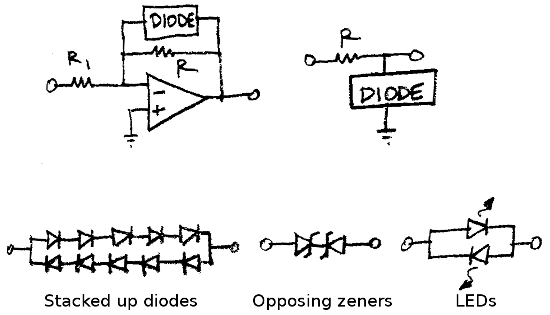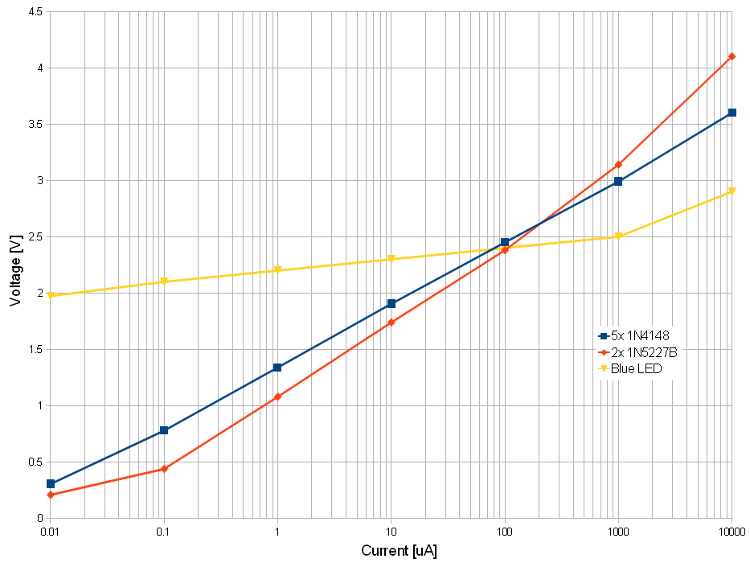Analysis of Diodes for Voltage Clamping
Overview
There are a number of different ways to limit the voltage at a particular point in a circuit. Two common ways are shown below. These use the turn-on voltage of a diode to limit current flow below a certain threshold, and to clamp the voltage above that threshold. The first circuit shows the diodes in the feedback loop of an opamp, and the second just uses a resistor (R) to limit the current when the diodes turn on. Three different diode clamps are shown directly below this, with the first being a stack of normal diodes, the second being back to back zeners, and the third using LEDs.

It is often desirable to have a hard cut-off in the clamping circuit. This means the diodes do not effect the circut at all below the clamp voltage (they draw no current and create no distortion), and above the clamp voltage they act as a short, holding the output fixed, regardless of the input. The three different diode configurations shown above were tested for their voltage-current relationships, to see how well they would perform in voltage clamping applications. A graph of their performance is shown below:

It can be seen that the zener (1N5227B - 3.6V) and 1N4148 diodes turn on gradually (exponentially, actually), whereas the LED is either on or off, conducting negligible current below 2.5V. This means that the zener and 1N4148 circuits will distort for some middle region where the current through them is comparable to the current through R, but the voltage is still below the clamp voltage. Whether this a problem depends upon the amount of distortion you can tolerate, and the difference between operating voltage and clamp voltage. For instance, if the operating voltage is 1V, and the clamp voltage is 3V, the 1N4148 setup will conduct 250nA under normal circumstances, and 1mA when clipping. This is a 1:4000 ratio, so distortion should be pretty minimal. But, if the operating peak is 2.5V, then the ratio is just 1:10, so there will be a fair bit of distortion present.
Opamp Versus Passive
The main difference between the opamp and passive circuits shown above, is the output impedance of the circuit. The passive circuit will have an ouput impedance of R, which needs to be picked large enough to limit current flow from the previous stage. This current should be limited to prevent damage to whatever is driving it, to limit power consumption of the whole circuit, and to reduce switching noise on the powersupply induced by the diode current quickly turning on and off. What exactly this max current value is depends upon the circuit requirements, but typically 1mA would be a good choice. You could go as high as 10mA without damaging circuitry, but switching noise would become a problem.
For the passive circuit, R is chosen based on the clamp voltage, and the peak voltage. So a 15V peak input with a 5V clamp leaves 10V across the resistor. If resistor current is to be kept to 1mA, then R = 10V/1mA = 10k. If current is limited to 10mA, this becomes 1k. For the opamp circuit, the current is limited by R1. Since the other side of R1 is at a virtual ground, the current is just the peak voltage divided by resistance. For 1mA max current, R1 = 15V/1mA = 15k. For the opamp circuit, R is then selected to give the appropriate circuit gain.
Diode Capacitance
Although the 1N4148 diodes faired poorly in comparison to the blue LEDs in terms of forward current, they have one very large advantage over the zener diodes or LEDs: low capacitance. The capacitance of the clamping circuit works in parallel with the resistor (R) to low-pass filter the signal. This filter may be an issue, depending upon the bandwidth required by the circuit. For accurately passing sawtooth or square waves, banwidth into the MHz range is required. To limit this effect, either R or C needs to be reduced. There are limitations on how small R can become due to output current of the opamp and the gain required by the circuit. So, if C needs to be as small as possible, the 1-3pF capacitance of the 1N4148 diode might be required. This capacitance is even further reduced by the fact that the diodes are in series, so the capacitance adds in parallel. In the example above, if each diode was 3pF, the total capacitance of a single string would be 3/5pF, and both strings in parallel would give 6/5pF. On the other hand, both the zener diodes and LEDs have capacitance in the 100-200pF range. The zener is better choice here, as its capacitance is halved, as there are two in series, whereas the LED capacitance is doubled, as the two are in parallel.
Leakage Current
Besides for conducting current when there is a small forward voltage across them, diodes also leak a bit of current when they are reverse biased. This leakage current is not a problem for the zener configuration, as the diodes are in series, so there is no leakage path. For the LED and 1N4148 setups this adds an additional distortion source, as there is always reverse biased diode(s) that can leak current. For the 1N4148 i measured 4nA of reverse leakage (this can be much smaller for other diodes), which is pretty small compared to the forward leakage, so perhaps not a major contributor to distortion. For the LED i measured 1nA with the LED uncovered, and 50pA with the LED covered. All diodes conduct when exposed to light, but LEDs are far more efficient at this, so its best to cover them up. This, suprisingly, makes the LED the better choice. But, be careful with large forward voltage drop LEDs (blue, purple, UV), as LEDs can typically only handle ~5V of reverse voltage. The parallel LED should keep the voltage below this under all cases, but its best to check the reverse voltage limit of your LED first.
